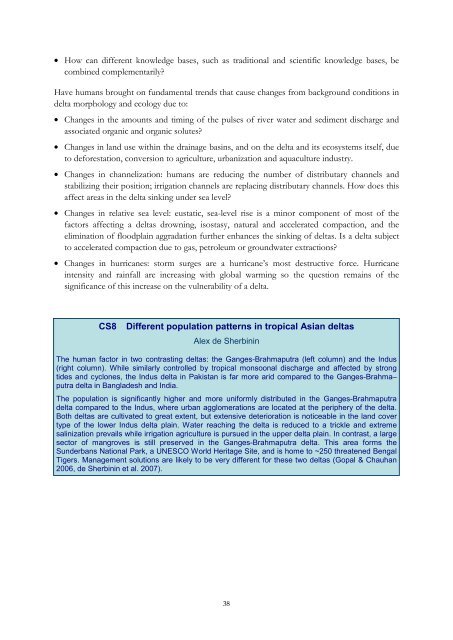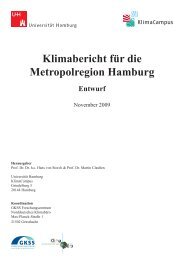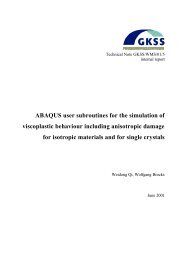Dynamics and Vulnerability of Delta Systems - loicz
Dynamics and Vulnerability of Delta Systems - loicz
Dynamics and Vulnerability of Delta Systems - loicz
You also want an ePaper? Increase the reach of your titles
YUMPU automatically turns print PDFs into web optimized ePapers that Google loves.
• How can different knowledge bases, such as traditional <strong>and</strong> scientific knowledge bases, be<br />
combined complementarily?<br />
Have humans brought on fundamental trends that cause changes from background conditions in<br />
delta morphology <strong>and</strong> ecology due to:<br />
• Changes in the amounts <strong>and</strong> timing <strong>of</strong> the pulses <strong>of</strong> river water <strong>and</strong> sediment discharge <strong>and</strong><br />
associated organic <strong>and</strong> organic solutes?<br />
• Changes in l<strong>and</strong> use within the drainage basins, <strong>and</strong> on the delta <strong>and</strong> its ecosystems itself, due<br />
to deforestation, conversion to agriculture, urbanization <strong>and</strong> aquaculture industry.<br />
• Changes in channelization: humans are reducing the number <strong>of</strong> distributary channels <strong>and</strong><br />
stabilizing their position; irrigation channels are replacing distributary channels. How does this<br />
affect areas in the delta sinking under sea level?<br />
• Changes in relative sea level: eustatic, sea-level rise is a minor component <strong>of</strong> most <strong>of</strong> the<br />
factors affecting a deltas drowning, isostasy, natural <strong>and</strong> accelerated compaction, <strong>and</strong> the<br />
elimination <strong>of</strong> floodplain aggradation further enhances the sinking <strong>of</strong> deltas. Is a delta subject<br />
to accelerated compaction due to gas, petroleum or groundwater extractions?<br />
• Changes in hurricanes: storm surges are a hurricane’s most destructive force. Hurricane<br />
intensity <strong>and</strong> rainfall are increasing with global warming so the question remains <strong>of</strong> the<br />
significance <strong>of</strong> this increase on the vulnerability <strong>of</strong> a delta.<br />
CS8 Different population patterns in tropical Asian deltas<br />
Alex de Sherbinin<br />
The human factor in two contrasting deltas: the Ganges-Brahmaputra (left column) <strong>and</strong> the Indus<br />
(right column). While similarly controlled by tropical monsoonal discharge <strong>and</strong> affected by strong<br />
tides <strong>and</strong> cyclones, the Indus delta in Pakistan is far more arid compared to the Ganges-Brahma–<br />
putra delta in Bangladesh <strong>and</strong> India.<br />
The population is significantly higher <strong>and</strong> more uniformly distributed in the Ganges-Brahmaputra<br />
delta compared to the Indus, where urban agglomerations are located at the periphery <strong>of</strong> the delta.<br />
Both deltas are cultivated to great extent, but extensive deterioration is noticeable in the l<strong>and</strong> cover<br />
type <strong>of</strong> the lower Indus delta plain. Water reaching the delta is reduced to a trickle <strong>and</strong> extreme<br />
salinization prevails while irrigation agriculture is pursued in the upper delta plain. In contrast, a large<br />
sector <strong>of</strong> mangroves is still preserved in the Ganges-Brahmaputra delta. This area forms the<br />
Sunderbans National Park, a UNESCO World Heritage Site, <strong>and</strong> is home to ~250 threatened Bengal<br />
Tigers. Management solutions are likely to be very different for these two deltas (Gopal & Chauhan<br />
2006, de Sherbinin et al. 2007).<br />
38





